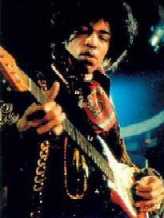
(Click on Jimi to hear his feedback virtuosity)
Cool! Where's my drill??!?! \
AHHH! NOT
AGAIN!!!
/
| Music Gear Repair and Hacking /\ | ||
|
Check out my YouTube channel. |

(Click on Jimi to hear his feedback virtuosity) |
Cool! Where's my drill??!?! \ |
AHHH! NOT
AGAIN!!!
/
|
I built this device in an effort to sound like Jimi without bothering the neighbors or blowing out my eardrums. The concept is very simple...sound travels through solids a lot better than it does through air. So if you apply the vibrations of the guitar sound right to the guitar, Hendrix-like feedback effects will happen with way less power than if they go through air between the speaker and the guitar. The first part of the device is a rackmount box with a post-modern design:
+----------------------------------+
| | Audible
| +------> guitar
Clean | Craig Craig / | output
Guitar >-O O-Anderton--O O-Anderton+ |
Sound | \ Compressor / Spluffer \ |
| O--------------O v |
| DPDT Bypass Craig |
| Relay Anderton |
| ^ Tube Sound |
| | Fuzz |
| / | |
| Feedback v |
| On/Off Guts from |
On Sw--|--->Flip battery- |
Off Sw--|--->Flop powered |
| \ practice amp |
| \ | |
| \ O |
| +--------------->/ |
| O |
| | |
+----------------------------------+
|
v
To feedback transducer
A transducer is used to apply the guitar vibrations to the guitar in some way. Two possible ways to do this are:
|
|
|
Here is me using the guitar-mounted version of the feedback generator on Pat Jordan's tune "Dolls" from the album With My Bathroom Fixtures I Shall Rule The World by Iconoclast: |
(255K mp3) |
| Here is me playing with the guitar slide version: | (196K mp3) |
| Here is me playing Happy Birthday with a more recent (July 2005) kludged-together feedback generator. I did this one for my sister's birthday. | (721K mp3) |
Of course, after I built this I realized others have used the same idea: Sustainiac Model C.
Someone told me there was a device many years ago called the "Feedback Extravaganza" or something that worked like this. If anyone knows anything about this, please email me.
The Fernandes Sustainer uses a different method to get a similar result. It uses an electromagnetic driver (a pickup being used backwards) to drive the strings rather than an acoustic transducer.
Lately (August 2005) I've been working a pedalboard version of the feedback generator using a bunch of Danelectro mini-pedals. I'll keep the page updated as I make progress.
+----------+ +-----+
|Surf&Turf | |PB&J | +------------+
Guitar --->|Compressor+--+--->|Delay+------>|Roland GP-16+--> Audible output |
+----------+ | +-----+ +------------+
v
+----------------------+
| Pedal-controlled |
| short delay |
|(Modified Hash Browns |
| Flanger inside Dunlop|
| rocker pedal; pedal |
| controls delay time) |
+----------+-----------+
|
v
+--------------+
| T-Bone |
| Distortion |
+-------+------+
|
v
+---------------+
| Fish & |
| Chips EQ |
+-------+-------+
|
v
+----------------------+
| Bacon & Eggs |
| Mini Amp |
| (modified for |
| speaker output |
| and less distortion) |
+----------+-----------+
|
Transducer<------+
Changing the phase relationship between the guitar string and the signal to the feedback transducer can cause the feedback to jump to a different harmonic of the note you're playing. I modified my Hash Browns Flanger so that it outputs only delayed signal, and the delay time is controlled by the pot that was originally the "Depth" pot. After my mod, the LFO that normally sweeps the flanger's delay time has been disabled, and the delay time stays fixed when you are not moving the pot.
| Effect of delay time on feedback | (483K mp3) |
Putting an echo effect with a longer delay time in the chain (PB&J Delay) causes wonderful beating effects when the transducer is moved along the string and the old echoes beat against the new ones.
| Echo beating | (636K mp3) |